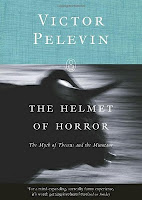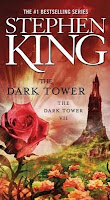Vote for your favourite. I'm going with Thomas Hardy personally. Is it bad that I've never read Little Women?
The Book Mine Set: The Great Wednesday Compare #5- Louisa May Alcott VERSUS Thomas Hardy
Wednesday, February 24, 2010
Monday, February 22, 2010
Escape to Etobicoke
 “Escape to Etobicoke” is a short story in the collection The Book of Ifs and Buts by Rabindranath Maharaj. I was drawn to this collection for a couple reasons. I liked the title. I liked the book cover. I liked the name of the author. After reading the little blurb about him on the back, I thought he was someone I could relate too. (Maharaj immigrated to Canada from Trinidad, just like my parents.) Therefore, I had to buy his book of short stories.
“Escape to Etobicoke” is a short story in the collection The Book of Ifs and Buts by Rabindranath Maharaj. I was drawn to this collection for a couple reasons. I liked the title. I liked the book cover. I liked the name of the author. After reading the little blurb about him on the back, I thought he was someone I could relate too. (Maharaj immigrated to Canada from Trinidad, just like my parents.) Therefore, I had to buy his book of short stories.Like other stories in the collection, “Escape to Etobicoke” is about the issues immigrants face when moving to Canada. The main character, Robert, was journalist at a prominent Trinidadian newspaper. Now he tutors a boy in English. He tries to make his life work here. He talks about the relatives he stayed with, also immigrants, formerly teachers. Now they’re shift workers. He talks about their children, who are Canadian, who speak differently, act differently from their parents and what that does to their family. He faces difficulties trying to make this new life for himself and refuses to go back to Trinidad.
The story takes the form of a letter to a friend. I’m never sure with letters-as-short-stories. Is this really the way someone would write a letter? I don’t think so. Maharaj actually seems to address this issue. In the letter, the writer, referring to the language that he’s using, says that he’s not a poet. The reader remembers that he is a journalist and so then presumably has a way with words.
I like that the main character describes what he has come to learn as the difference between Americans and Canadians. I also like the way he describes the hardships faced by immigrants. He does this without being melodramatic or begging for sympathy. It’s a description of his experiences. You get the feeling that perhaps “Escape to Etobicoke” started as an actual letter that Maharaj wrote to someone back in Trinidad. I suppose there's a lot I like about this story and the collection it comes from.
Wednesday, February 17, 2010
Saturday, February 13, 2010
The Helmet of Horror

 I’m not even sure where to begin. I finished The Helmet of Horror a lot faster than I thought I would. It only took two days; I couldn’t put it down. I could have read it in one if I had the time. I’m thinking about it now, even considering re-reading it. There’s so much symbolism and philosophical thought I’m certain I missed. I’m never sure with translations, whether to attribute the readability to the author or translator, but the language was engaging and easy to follow. The concept however, is all Victor Pelevin.
I’m not even sure where to begin. I finished The Helmet of Horror a lot faster than I thought I would. It only took two days; I couldn’t put it down. I could have read it in one if I had the time. I’m thinking about it now, even considering re-reading it. There’s so much symbolism and philosophical thought I’m certain I missed. I’m never sure with translations, whether to attribute the readability to the author or translator, but the language was engaging and easy to follow. The concept however, is all Victor Pelevin.
The Helmet of Horror is a modern re-telling of the myth of Theseus and the Minotaur. For those that don’t know, Theseus has to find his way out of a labyrinth while being pursued by a Minotaur. He uses a magic ball of string to find his way out and kills the Minotaur. There’s more to the myth that you can find here.
The novel is written entirely in dialogue, but without any of the characters actually speaking to each other. It takes place in an internet style chatroom. I say “internet style” because they actually aren’t on the internet; they can’t access anything with their computers except the chatroom. Their only interaction with anyone is through the computer screen; there are no voices or faces. They can’t share any personal information, not even their names. Each person is assigned a pseudonym, which they can’t change.
ASIDE: You can see what I mean with a preview from Google Books. I just discovered it as I was looking for an image of the front cover to add to this post. I tried a few other books out. It has previews for quite a few. I think I might use this in the future. I vaguely remember some kind of legal thing in the news about Google and publishers. Well, hopefully they’ve solved that problem.
There are mysterious moderators. There is a search for Theseus. Who is Asterisks? There is religion, philosophy and an incomprehensible Helmet of Horror. There is no proof than anyone the characters “speak” with is real.
Victor Pelevin’s The Helmet of Horror is a great addition to the Myth Series. Unlike the last Myth book I read, this one makes me eager to read another.
Friday, February 12, 2010
Rhyme Stew
 Rhyme Stew is a great little book of satirical poetry by Roald Dahl. It was given to me with a few other books for my daughter. Like I do with other books, before reading this to my child, I read it for myself. I’m glad I did. The cover of Rhyme Stew has the recognizable Quentin Blake illustrations. On the side of the cauldron it says, “WARNING Unsuitable for Small People.” It really is. For example, the short poem, St Ives:
Rhyme Stew is a great little book of satirical poetry by Roald Dahl. It was given to me with a few other books for my daughter. Like I do with other books, before reading this to my child, I read it for myself. I’m glad I did. The cover of Rhyme Stew has the recognizable Quentin Blake illustrations. On the side of the cauldron it says, “WARNING Unsuitable for Small People.” It really is. For example, the short poem, St Ives:As I was going to St Ives
I met a man with seven wives
Said he, “I think it’s much more fun
Than getting stuck with only one.”
I thought it was hilarious, but would I read it (then have to explain it) to a small child? Not likely. This isn’t even the most inappropriate one. There’s nudity, a vicar feeling the thigh of a woman, cat kicking and thievery. This book should be rated at least PG-13. I was quite surprised by the content. Though I enjoyed it, I think it’ll be a while before I let my daughter read it.
Wednesday, February 10, 2010
The Dark Tower VII: The Dark Tower

 I’ve finally finished Stephen King’s Dark Tower series (not including the graphic novels). I think I read the first book, The Gunslinger when I was thirteen, maybe fourteen. Let’s just say that was a very long time ago. How do I feel now? I don’t know. Happy to know how it ends, definitely. I’m not sure what I think of the ending. To those who have read the book: The horn makes it different, right?
I’ve finally finished Stephen King’s Dark Tower series (not including the graphic novels). I think I read the first book, The Gunslinger when I was thirteen, maybe fourteen. Let’s just say that was a very long time ago. How do I feel now? I don’t know. Happy to know how it ends, definitely. I’m not sure what I think of the ending. To those who have read the book: The horn makes it different, right?At the end of The Dark Tower (and most of the others in the series) King includes an “Author’s Note”. In it, he asks that readers not send him angry letters; he won’t answer them. I could have been happy if he had just ended after the “Prologue,” but no, he writes something that could make a lot of readers angry. Before what he titles “Coda,” King includes an appeal of sorts, telling the readers they have a choice, they don’t have to read this part. They can enjoy the end as it is. Does he really think people won’t read the last few pages of the book? At least it’s an ending with a little glimmer of hope.
The Dark Tower is a long book. The copy I have is 845 pages. As much as I like this novel, I have the same problem with it that I’ve had with the last three in the series. The beginning starts great, but then it hits a chunk of story that’s too much talking, too much explaining of things that I don’t think matter. Then, when you get to the second half, it moves quickly and the story picks up an amazing flow. I think I might have said this with the last book of his I read, the book could have easily been a hundred pages shorter. Does this ever stop me from reading his books? No. They are exciting stories that I enjoy.
Monday, February 01, 2010
A Haunted House
.jpg) Inspired to read, A Haunted House by Nan’s review last week, I dove into my collection of Virginia Woolf’s short fiction for this week's installment of Short Story Monday. It wasn’t a very deep dive since A Haunted House isn’t even two full pages long. It is however, Woolf’s distinct “stream of consciousness” style. The reader moves along with both couples, living and dead, as they search and go about there day. I love the end. A Haunted House isn’t a scary ghost story. It’s sweet, with just a touch of creepy. It’s perfect for a Woolf lover or a Woolf beginner.
Inspired to read, A Haunted House by Nan’s review last week, I dove into my collection of Virginia Woolf’s short fiction for this week's installment of Short Story Monday. It wasn’t a very deep dive since A Haunted House isn’t even two full pages long. It is however, Woolf’s distinct “stream of consciousness” style. The reader moves along with both couples, living and dead, as they search and go about there day. I love the end. A Haunted House isn’t a scary ghost story. It’s sweet, with just a touch of creepy. It’s perfect for a Woolf lover or a Woolf beginner.
Subscribe to:
Posts (Atom)